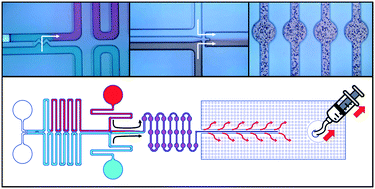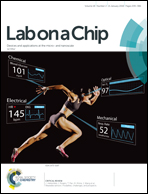A robust, portable and backflow-free micromixing device based on both capillary- and vacuum-driven flows†
Abstract
In capillary- or vacuum-driven microfluidics, surge backflow events are common when merging or pumping two similar or dissimilar liquids together if a pressure difference exists between them. In this work, a robust, portable micromixing device that is insensitive to backflow was designed, fabricated and characterised. A capillary-driven pressure balancing bypass connected between two inlet ports diminished the initial pressure difference caused by capillarity and gravity present in each liquid at the two inlet ports. Then, using manual syringe-assisted vacuum-driven pumping that operated based on the high gas permeability of polydimethylsiloxane, the two pre-balanced liquid streams could synchronously enter a dead-end micromixing channel without any backflow. To test the performance of this device, we first used it to mix two aqueous solutions of different coloured dyes. We varied the initial volume difference between the solutions to study the effect of gravity-induced pressure difference on mixing. Next, as a proof-of-concept application, ABO/Rh blood groups were successfully determined through detection of blood antigen–antibody agglutination. The filling time of agglutinated samples, driven by the simple syringe-assisted pumping, in the dead-end mixing channel was consistently 10% longer than that of blood samples without the agglutination reaction. Thus, the proposed device shows great potential for use in a wide variety of blood typing assays, agglutination-based assays and point-of-care or lab-on-a-chip testing applications.



 Please wait while we load your content...
Please wait while we load your content...